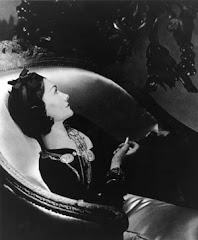Sunday, 23 March 2008
On not being able to leave the house

“The hardest thing to sell at the moment is a black kitten heel,” says Rebecca Farrar-Hockley, the buying and creative director of Kurt Geiger. According to her, a shoe boom is nigh, spurred on by It-bag fatigue and pared-down ready-to-wear.
Posted by
Linda Grant
at
07:45
3
comments
![]()
![]()
![]()
![]()
Labels: Shoes
Incredibly useful article about shopping in Paris

. . . and how to look like a Parisian. Here
I was in Paris in September and the key to looking like a Frenchwoman is scarves. Artfully tied.
Posted by
Linda Grant
at
06:36
5
comments
![]()
![]()
![]()
![]()
Labels: Shopping
Do you want to look old?
I have a piece in today's Telegraph about a new book about to come out in the UK but which has already courted controversy in the US, Charla Krupp's 'How Not To Look Old.'
In the 1950s and 1960s there was a craze in America for a procedure called rhinoplasty, in which a cosmetic surgeon broke the patient's nose to give her a new, always smaller, one. Little upturned ski-slope noses sat on faces they did not fit, but they had solved an age-old problem: how not to look Jewish in Wasp America. When Charla Krupp published her how-to manual in America at the beginning of this year, entitled How Not To Look Old, there was something of a furore in the press. Krupp argued that, since older women were discriminated against, the best way they could deal with the issue was not by tackling the discrimination politically, but by changing the way they look. As she pointed out in the New York Times, 'There was a book on how not to look Jewish. It was called The Preppy Handbook and it was a bestseller.'
But Krupp's book touched a raw nerve in the American media. 'Age management' is the essence of her thesis. 'Until age becomes a non-issue,' she writes, 'I don't think it's particularly smart for women to advertise their age… As Christie Brinkley said in her CoverGirl commercials, "I love being the age I am, I just don't want to look it." No one wants to "look it", because of age profiling and the fear of being outed. Why does anyone, besides your doctor, need to know your age anyway?'
To the feminist baby-boomer generation it was an outrage, for they (and that includes me) were the first to challenge every assumption about women's lives from contraception to menopause. To a politically correct American media, Krupp's book was as shocking as suggesting that Barack Obama use bleaching agents to lighten his skin; and yet during the presidential race Hillary Clinton has been proudly promoting feminist values with a face that looks suspiciously stiffened by Botox and a glare of forensic scrutiny about her appearance that her Republican rival, John McCain, aged 72, has evaded. For the reality for many of those outraged women is that in a highly competitive workforce and a culture in which celebrities are never seen to age - where all the role models have had face-lifts and a 50-year-old looks 35 - it is hard to get a job when you resemble the age on your birth certificate.
The baby-boomers' unique selling point has always been youth. We are a generation born, we believed, to be young and stay younger forever, as if ageing were a lifestyle choice for our parents, a more conservative generation who longed for Crimplene dresses and set hair. But, though the generation born after the war and up to the early 1960s has rewritten most of the rules about how to behave over 40, watching iconic figures such as Twiggy age and become the face of Marks & Spencer's with-it granny look has been extraordinarily unnerving. Sir Paul McCartney's perennially bad hair-dye job, and Mick Jagger's wrinkled visage beneath his own light-brown locks, remind us that there is no real Dorian Gray option, short of the surgeon's knife.
Read on
Posted by
Linda Grant
at
06:22
5
comments
![]()
![]()
![]()
![]()
Labels: Published work, The Great Mutton Debate.
Thought for the day
Posted by
Linda Grant
at
06:19
0
comments
![]()
![]()
![]()
![]()
Labels: Thought for the day



